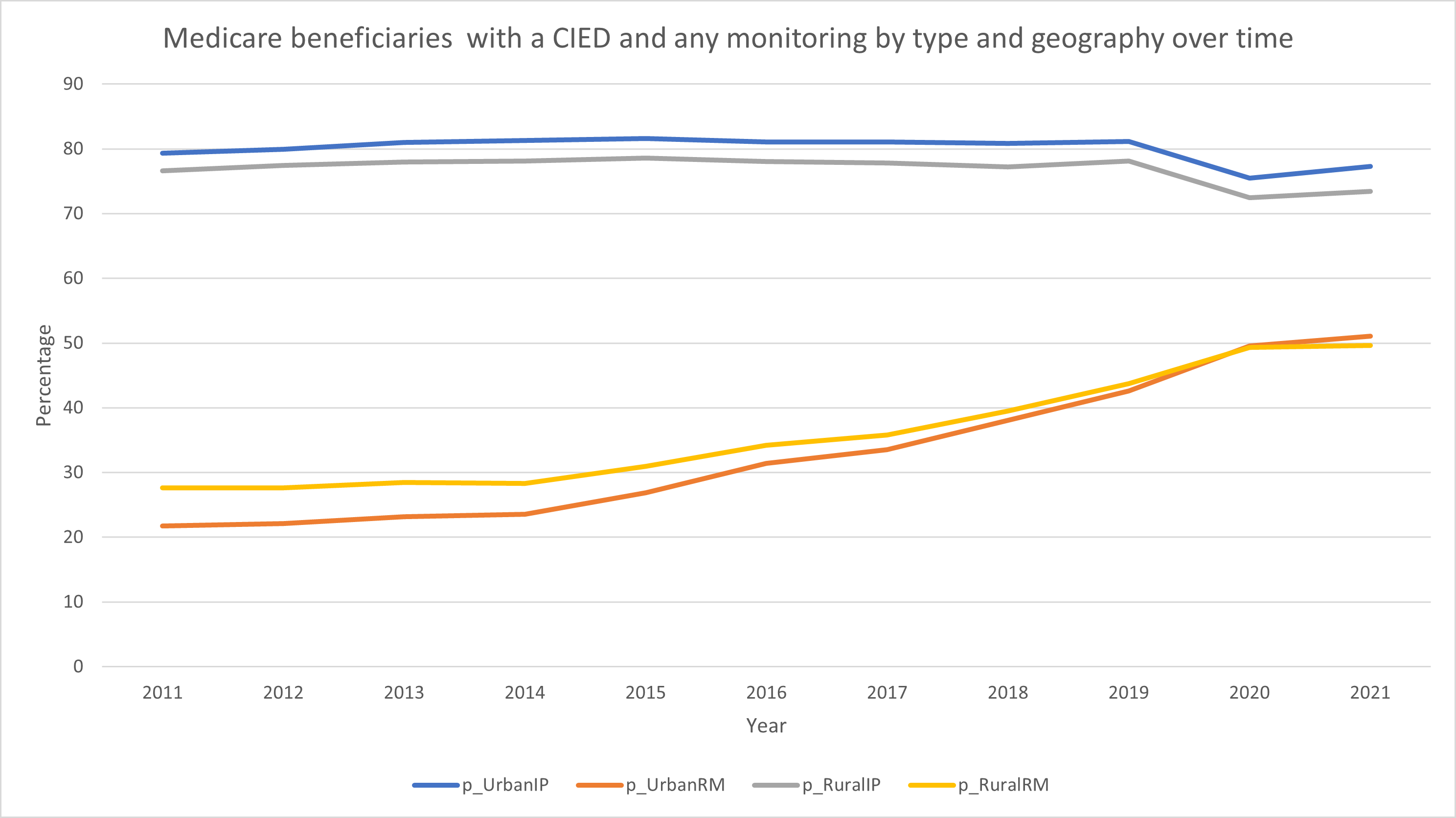Final ID: Mo2095
Rural and Urban Patterns of Monitoring of Implanted Cardiac Devices in the US
Abstract Body (Do not enter title and authors here): Background: Along with in-person (IP) monitoring, remote monitoring (RM) is recommended for patients with a cardiac implantable electronic device (CIED) to improve clinical outcomes.
Hypothesis: Rurality will adversely impact the delivery of both RM and IP monitoring as part of comprehensive CIED care.
Aims: To define and compare CIED monitoring patterns among patients with a CIED in rural and urban geographies.
Methods: All Medicare fee-for-service beneficiaries (2011-2021) with history of CIED implantation were included based on relevant CPT codes. Demographic characteristics were reported by implant year and stratified by rurality based on beneficiary rural-urban commuting area code. All IP and RM events in the year following implant were tabulated based on CPT and ICD-9/10 procedure codes and similarly stratified by geography.
Results: Approximately 23% of the de novo CIED implants (approximately 150,000/year) were among patients living in rural areas. The mean age was 79-80 years across the study period and was slightly higher (<1 yr difference) in the urban group; the proportion of men was similar in each group (~57%). Comorbidity was high in both geographic strata throughout the study period, including hypertension (~94%), ischemic heart disease (~80%) and heart failure (~65%). In the year following implant, the proportion of patients with ≥1 IP monitoring event was stable and consistently greater among the urban than rural cohort (~81% vs ~78% in 2019) until 2020 when the proportion fell for both groups (75% vs 72%, respectively) (Figure). The proportion of patients with ≥1 RM event rose substantially over the study period (from 22% to 51% in the urban group and 28% to 50% in the rural group).
Conclusions: Dramatic improvements in RM were observed among Medicare beneficiaries with a CIED in the last decade. Patients in rural areas were historically more likely to undergo RM than their urban counterparts, but this gap narrowed and equalized over time. By 2020, a decline in IP monitoring was accompanied by an increase of growth in RM in both urban and rural areas, possibly reflecting effects of the COVID pandemic on CIED care access.
Hypothesis: Rurality will adversely impact the delivery of both RM and IP monitoring as part of comprehensive CIED care.
Aims: To define and compare CIED monitoring patterns among patients with a CIED in rural and urban geographies.
Methods: All Medicare fee-for-service beneficiaries (2011-2021) with history of CIED implantation were included based on relevant CPT codes. Demographic characteristics were reported by implant year and stratified by rurality based on beneficiary rural-urban commuting area code. All IP and RM events in the year following implant were tabulated based on CPT and ICD-9/10 procedure codes and similarly stratified by geography.
Results: Approximately 23% of the de novo CIED implants (approximately 150,000/year) were among patients living in rural areas. The mean age was 79-80 years across the study period and was slightly higher (<1 yr difference) in the urban group; the proportion of men was similar in each group (~57%). Comorbidity was high in both geographic strata throughout the study period, including hypertension (~94%), ischemic heart disease (~80%) and heart failure (~65%). In the year following implant, the proportion of patients with ≥1 IP monitoring event was stable and consistently greater among the urban than rural cohort (~81% vs ~78% in 2019) until 2020 when the proportion fell for both groups (75% vs 72%, respectively) (Figure). The proportion of patients with ≥1 RM event rose substantially over the study period (from 22% to 51% in the urban group and 28% to 50% in the rural group).
Conclusions: Dramatic improvements in RM were observed among Medicare beneficiaries with a CIED in the last decade. Patients in rural areas were historically more likely to undergo RM than their urban counterparts, but this gap narrowed and equalized over time. By 2020, a decline in IP monitoring was accompanied by an increase of growth in RM in both urban and rural areas, possibly reflecting effects of the COVID pandemic on CIED care access.
More abstracts on this topic:
Comparative Study of Electrophysiologic Pacing Parameters in Patients with Chagas Disease from Honduras
Baez Andrew, Chavez Dorys, Tracy Cynthia, Mercader Marco
Analysis of Factors and Paths Influencing the Health Information Seeking Behavior of Stroke PatientsChen Lu, He Manlan, Hu Yufan

